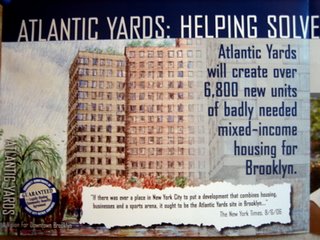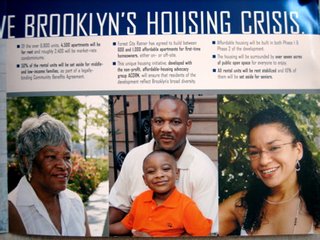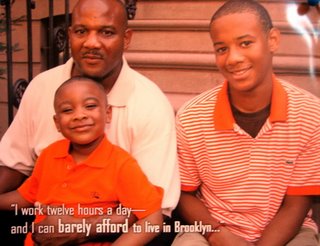 The latest Atlantic Yards p.r. flier has already been dissected by the Brooklyn Record and No Land Grab, but a few details deserve emphasis. First, let's note that Forest City Ratner finally did show the public some towers, unlike in the brochure distributed in May. However, the towers here only go about 15 stories tall. However, only one of the 16 buildings planned would be under 200 feet, at 184 feet.
The latest Atlantic Yards p.r. flier has already been dissected by the Brooklyn Record and No Land Grab, but a few details deserve emphasis. First, let's note that Forest City Ratner finally did show the public some towers, unlike in the brochure distributed in May. However, the towers here only go about 15 stories tall. However, only one of the 16 buildings planned would be under 200 feet, at 184 feet.Second, the flier requires footnotes. The statement that "50% of the rental units will be set aside for middle- and low-income families" papers over the actual affordability of the units.
Actually, only 900 (40%) of 2250 affordable rentals would go to families with an annual household income of $35,450 or lower. And 900 of the affordable rentals would rent for more than $2000 a month
550 in Phase 1
 And the statement that "affordable housing will be built in both Phase 1 and Phase 2 of the development" lacks specifics. As the City Planning Commission said in a letter last week, "at least 30% of the units built in Phase 1 (approximately 550 units) will be affordable."
And the statement that "affordable housing will be built in both Phase 1 and Phase 2 of the development" lacks specifics. As the City Planning Commission said in a letter last week, "at least 30% of the units built in Phase 1 (approximately 550 units) will be affordable."If Phase 1 takes four years, as planned, that means 137.5 affordable units a year, including 55 units a year for families at or below Brooklyn's median household income. And there's no assurance that Phase 2 would be built, since it depends on market conditions and other factors.
Decoding the flier
 The copy in the flier--about the difficulty of living in Brooklyn--taps into a legitimate concern. The choice to feature minorities in the brochure misleadingly suggests that this is mainly a project to assist them.
The copy in the flier--about the difficulty of living in Brooklyn--taps into a legitimate concern. The choice to feature minorities in the brochure misleadingly suggests that this is mainly a project to assist them.If Forest City Ratner really cared about affordable housing--rather than advancing a project that could bring a billion dollars in profits--the developer would have taken advantage of several opportunities to inform the public of the effort to reform the city's 421-a tax break, which subsidizes much market-rate construction without requiring any affordable units. It hasn't.
Comments
Post a Comment